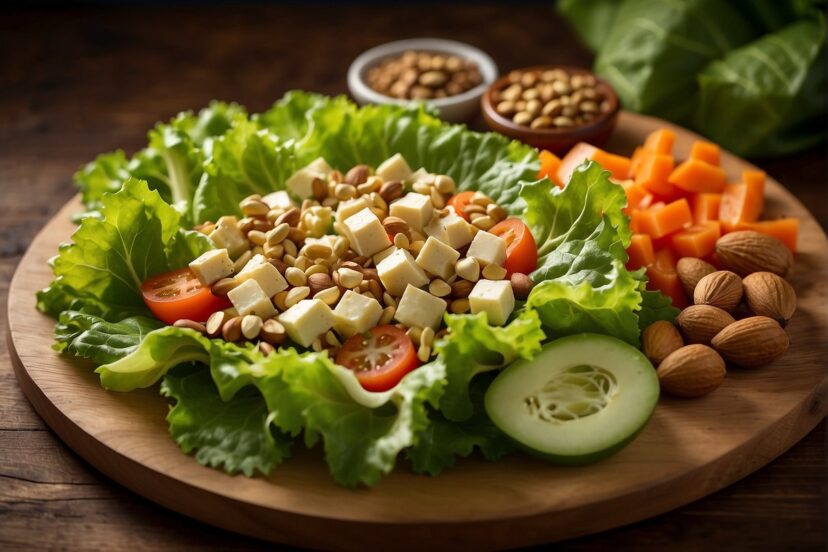Vegetarian Lettuce Wraps: A Healthy and Flavorful Meal Option
*We may earn a commission for purchases made using our links. Please see our disclosure to learn more.
Vegetarian Lettuce Wraps: A Healthy and Flavorful Meal Option
Vegetarian lettuce wraps are a versatile and health-conscious choice for anyone looking to enjoy a delicious appetizer or a light meal. In my experience, they are not only easy to make but also packed with nutrients, offering a fresh alternative to traditional wraps that often rely on heavier breads or rice. I find the crispness of the lettuce pairs beautifully with a variety of fillings, from savory tofu and mushrooms to vibrant vegetables and herbs, all while keeping the dish low in calories and carbohydrates.
Creating vegetarian lettuce wraps at home is a quick process that can be adapted to include your favorite ingredients or whatever you have on hand. I appreciate that these wraps can effortlessly accommodate different dietary requirements, including vegan and gluten-free options, without sacrificing flavor. The key is to focus on fresh produce and a balance of textures, while a tasty sauce can elevate the filling to new heights.
As an appetizer, vegetarian lettuce wraps are a crowd-pleaser that won’t leave guests feeling overly full. Their healthy profile and ease of assembly make them a smart choice for gatherings or a simple family dinner. I always enjoy experimenting with different combinations of ingredients and flavors, finding that each new variation of a lettuce wrap is an opportunity to explore global cuisines in a fun, accessible format.
Nutritional Profile

Vegetarian lettuce wraps present a nutritious option, often low in calories and high in various vitamins and minerals. Here, I break down the key nutritional elements to consider.
Vitamins and Minerals
- Vitamin A: Essential for eye health and immune function.
- Vitamin C: Important for skin health and immune support.
- Calcium: Contributes to bone health and muscle function.
- Iron: Crucial for blood health and energy levels.
- Potassium: Helps control blood pressure and supports heart function.
Typically, these wraps harness ingredients like tofu and vegetables, which are natural sources of these vitamins and minerals.
Calories and Macronutrients
- Calories: On average, a wrap provides approximately 106 calories (based on a 158g serving).
- Protein: Content is relatively high, with wraps containing about 7.9 grams, thanks to protein-rich ingredients like tofu.
- Fat: Total fat is around 5.3 grams per wrap, with a balance of saturated, polyunsaturated, and monounsaturated fats.
- Carbs: Carbohydrates average 8.9 grams, with dietary fiber at 1.9 grams, aiding digestion.
- Sodium: With an intake of 346mg per wrap, it’s a moderate amount and should be consumed carefully, especially for those monitoring their salt intake.
These values can vary based on specific ingredients used and serving sizes. My focus is on giving you an accurate depiction of what to expect nutritionally from a typical vegetarian lettuce wrap.
Selecting Ingredients
In constructing delicious vegetarian lettuce wraps, I focus on choosing fresh, flavorful components that blend together harmoniously. The crispness of the lettuce, the richness of the protein, and the burst of flavor from vegetables and add-ins are all pivotal to the final taste.

Lettuce Varieties
The base of any lettuce wrap is, unsurprisingly, the lettuce. I recommend using varieties that hold their shape well and offer a crunchy texture. Here are some of my top picks:
- Romaine: Sturdy and crunchy, it’s perfect for holding substantial fillings.
- Butterhead (Boston or Bibb): Offers tender, yet strong leaves that are easy to fold.
- Iceberg: Its crispness is unmatched, making it ideal for a cool, crunchy bite.
Protein Sources
For a robust vegetarian wrap, the protein should be hearty and flavorsome. I tend to include:
- Tofu: Firm tofu, crumbled or diced, absorbs sauces like soy sauce well, providing a meaty texture.
- Tempeh: Its nutty flavor and substantial bite make tempeh an excellent choice.
- Mushrooms: Cremini mushrooms are a personal favorite for their depth of flavor and meaty consistency when cooked.
Vegetables and Add-ins
A medley of veggies adds color, texture, and nutrition. Here’s what I typically reach for, always ensuring they are chopped or shredded to meld well within the wrap:
- Carrots: Julienned or shredded for a sweet crunch.
- Bell Peppers: Thinly sliced for a crisp, vibrant addition.
- Green Onions & Radish: Offer a sharp, peppery kick that complements other flavors.
- Cabbage & Sweet Potato: Shredded cabbage for a crisp bite and diced sweet potato for a tender, hearty element.
To elevate the wraps further, I like to sprinkle sesame seeds for a nutty accent or red pepper flakes for a hint of heat. For creaminess, diced avocado works wonders.
As for seasonings, I rely on a mix of garlic, green onions, and sometimes a dash of soy sauce to achieve that savory umami balance that defines a stellar vegetarian lettuce wrap.
Preparing the Wraps

Before assembling vegetarian lettuce wraps, it’s crucial to prepare a robust flavor base and choose the right type of lettuce for a satisfying crunch.
Sauces and Flavorings
To begin, I craft a savory sauce that will infuse the wraps with rich flavors. A blend of hoisin sauce and rice vinegar provides a sweet and tangy profile, while toasted sesame oil adds a nutty aroma. For a spicy kick, I incorporate sriracha to taste. Freshly minced ginger elevates the sauce with its pungent and spicy warmth. In some cases, a touch of lime juice can add a citrusy zing to the overall flavor palette.
Here is a simple table of my go-to sauce mixture:
| Ingredient | Quantity |
| Hoisin sauce | 1/4 cup |
| Rice vinegar | 2 tablespoons |
| Toasted sesame oil | 1 tablespoon |
| Sriracha | 1 teaspoon |
| Fresh ginger, minced | 1 tablespoon |
| Lime juice | 1 tablespoon |
I whisk these ingredients together until they’re well-combined and set the sauce aside, letting the flavors meld.
Wrap Assembly
Choosing the right lettuce is important for the structure and texture of the wraps. I opt for leaves that are sturdy yet pliable, such as iceberg lettuce, romaine lettuce, or bibb lettuce. These varieties also offer a crisp bite that contrasts well with the soft filling.
For the filling, I crumble firm tofu and sauté it until golden. I then stir in the sauce mixture, along with diced water chestnuts for crunch and black beans for additional protein. To incorporate fresh elements, I add chopped cucumbers, cilantro, basil, and parsley, enhancing the wraps with garden-fresh flavors. A sprinkle of chopped peanuts serves as a garnishing touch, providing a satisfying crunch.
I lay the lettuce leaves flat and spoon the tofu mixture onto each one, ensuring there’s a balance of flavors and textures. If serving to guests who prefer a creamy element, a dollop of hummus can be a welcoming addition. Finally, after folding the lettuce over the filling, my vegetarian lettuce wraps are ready to enjoy.
Serving Suggestions for Vegetarian Lettuce Wraps

When I prepare vegetarian lettuce wraps, I focus on balancing flavor and texture, ensuring that each bite is as satisfying as the next. The lettuce itself acts as a low-carb alternative to traditional tortillas, offering a crisp freshness to the dish. Here are some of my personal tips for serving:
Ingredients:
- Leafy Greens: Choose sturdy leaves like butter or romaine lettuce to hold your fillings. Iceberg lettuce can be used for extra crunch.
- Fillings: A mix of sautéed veggies such as carrot, mushrooms, and water chestnuts brings a delightful mix of textures that pairs well with a protein base like crumbled tofu or tempeh.
- Sauces: Dress up your wraps with creamy sauces. I often opt for a peanut butter or tamari-based sauce, which is a gluten-free soy sauce alternative, giving a rich umami flavor. Lime juice adds a tangy kick.
Enhancements:
- Mix in chopped cashews for a satisfying crunch.
- Introduce gluten-free rice noodles for a heartier wrap.
- Herbs like basil or cilantro can elevate the freshness of your wraps.
Tips:
- Balance: Aim for a balance between creamy elements and crunchy vegetables.
- Variety: Offer multiple sauces, from sweet to spicy, to cater to different palates.
- Innovate: Adapt the fillings based on what’s seasonal and available to you.
Chilled lettuce wraps can be a refreshing starter, reminiscent of spring rolls. Serve alongside a range of dipping sauces for an interactive and enjoyable meal. Trust me, with these tips, your vegetarian lettuce wraps can be just as addictive and delectable as the acclaimed PF Chang’s rendition, yet tailored to your personal taste and dietary preferences.
Frequently Asked Questions

In this section, I’ll address some of the common queries related to crafting delicious and healthy vegetarian lettuce wraps, revealing the versatility of ingredients and methods that can be employed in their creation.
1. What ingredients can be used to make Indian style vegetarian wraps using lettuce?
For Indian style wraps, I opt for ingredients like spiced paneer, chickpeas, or potatoes. I season these with traditional spices such as garam masala, cumin, and coriander, and wrap them in crisp lettuce leaves for a fresh take on Indian flavors.
2. How can you prepare vegetarian wraps with lettuce without including tofu?
You can create tasty lettuce wraps without tofu by substituting with tempeh, beans, lentils, or finely chopped vegetables. Portobello mushrooms also make a hearty and savory filling that’s rich in flavor.
3. What are some tips for creating healthy lettuce wraps suitable for a vegetarian diet?
When I make vegetarian lettuce wraps, I focus on including a variety of textures and nutrients. I use fresh vegetables for crunch, grains or legumes for protein, and a flavorful sauce or dressing that’s low in sugar. To keep them light, I avoid deep-frying any components.
4. Can you suggest an easy and quick recipe for vegetarian lettuce wraps?
A simple recipe would involve filling lettuce cups with a mixture of sautéed bell peppers, onions, and black beans. I season the filling with taco spices and top it with diced tomatoes and avocado for a Mexican-inspired wrap that’s both quick and satisfying.
5. How can one make vegetarian lettuce wraps in a Chinese style, mimicking restaurant flavors?
To capture the essence of Chinese-style lettuce wraps, I stir-fry a mix of mushrooms, water chestnuts, and finely diced vegetables, seasoning with soy sauce, hoisin sauce, ginger, and garlic. The mixture is then spooned into lettuce leaves and often garnished with green onions and sesame seeds.




